(Photo by Brian Rothmuller/Icon Sportswire)
One of the first things I got into when indexing plays, either at Baseball Reference or Baseball Savant, was to look and see what pitchers get the most called strikes out of the zone. I wrote about the topic for Fangraphs a few months ago which discussed Chicago Cubs‘ starter Jon Lester’s pattern of getting what I referred to as the ‘phantom strike’. I looked into the catching metrics, to include framing data, to see if his catchers were creating those opportunities. Essentially, it was out of the ‘glove’ of his catchers, post-David Ross era; Ross averaged 9.3 runs saved through his pitch framing skills. His predecessors did Lester no such favors.
Much like the Lester/Ross combo, the Arizona Diamondbacks appear to have a sneaky pair of batterymates. Actually, sneaky might be a slight but they are definitely getting away with something.
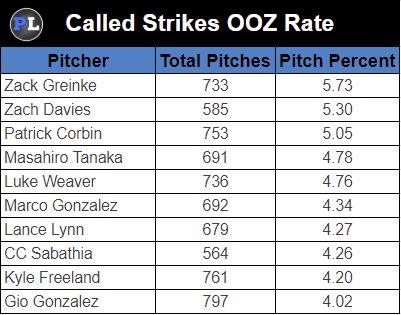
CHART 1 (As of May 14th)
Pitcher Zack Greinke and catcher Jeff Mathis are our culprits. Greinke (currently ranked 10th on The List) gets the start today at home versus the Milwaukee Brewers. As you see in chart 1, Greinke is getting called strikes out of the zone more than any other starter with at least 500 pitches thrown in 2018. Before we start diving into the analysis, lets first decide if this is something that normally occurs with Greinke as well as seeing if there is anything to it when it comes to Mathis.

TABLE 2
Chart 2 shows Greinke’s recent catcher history, to include pitch framing metrics with each catcher who caught at least 30% of his starts. For the unfamiliar, oStr% is the ratio of pitches that should have been called a ball but were reined in for a strike and RAA is the number of runs saved from pitch framing; positive is good, negative bad. Greinke had his best season in 2015 in terms of calls going his way. Yasmani Grandal has consistently been near the top of catcher rankings when looking specifically at what they do to assist pitchers. So it comes as no surprise that he helped Greinke have (by far) his best season of the last five years.
Using Greinke as our subject, we see a decent relationship between OOZ strike percentage with ERA and OBP. He had a huge dropoff in 2016 (showing his worst ERA and OBP) but bounced back in 2017; it doesn’t follow that the higher ranked Greinke is (OOZ K%), the better his pitching metrics. This is apparent in the correlation analysis I ran for the relationship between the rate of strikes called out of the zone and pitcher ERA. Using a threshold of 5000 pitches from 2015-2017, 118 pitchers qualified. The median OOZ called-strike rate was 3.09, 62 of which were above that average. Out of those 62, I found that using the two metrics produced a .07% coefficient of determination.
Pitchers rarely see the same ump more than twice. This causes the issue to be more volatile due to each ump having a different strike zone as well as their vulnerability to pitch framing. But there is much more to it than that; mainly the pitcher’s command and what count the pitch was thrown under. During the 2015 MIT Sloan Analytics Conference, Sports Info Solutions (Joe Rosales and Scott Spratt) conducted a vast and thorough study trying to zero in on who is ultimately responsible for a called strike. They provided a very interesting study on strike percent relative to average based on the count. Below is table 3, straight from the research paper.
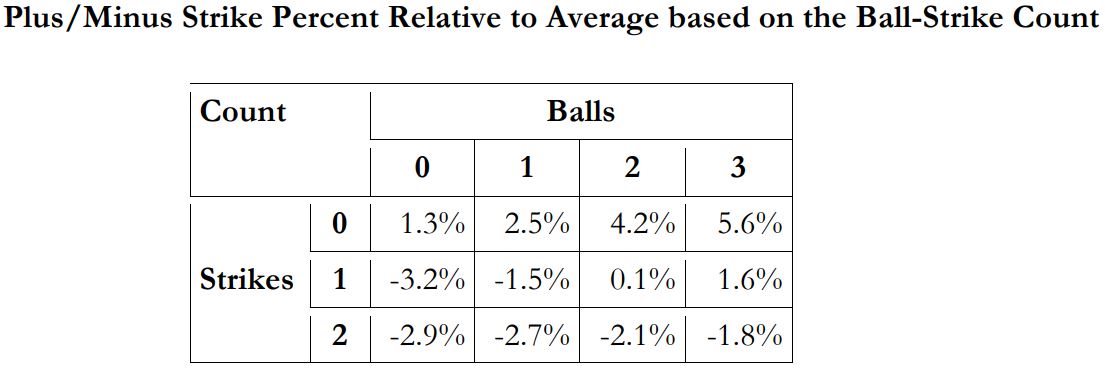
TABLE 3, Courtesy of SIS
Looking at table 3, you’ll see that 0-3 is the count that you’ll have the best chance to get a strike called, presumably so long as its close enough to the strike zone. Conversely, 1-0 is the count you’re least likely to get a strike called in your favor.
So let’s take a look at what kind of counts Greinke had himself in the most for 2015 and see if there is a relationship in 2018.

TABLE 4, 2015
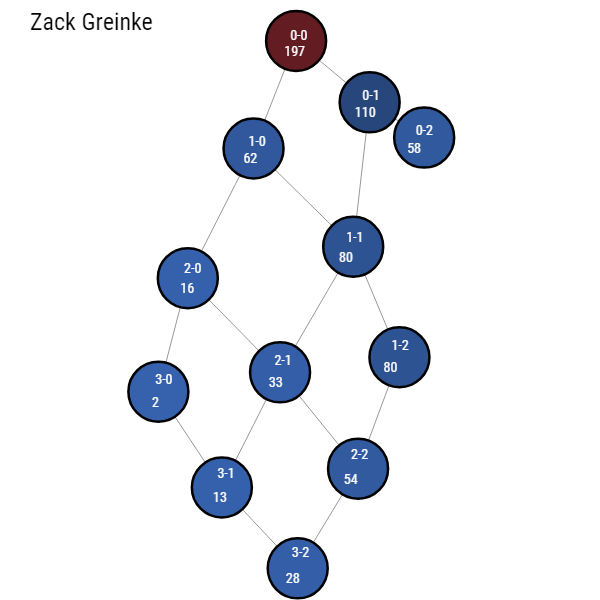
TABLE 5, 2018
While referencing table 3, what stands out is how little Greinke gets himself in 3-0 counts; the count that will get you a stray pitch called a strike most often. Then, you see how often Greinke has himself in two-strike counts (pitchers count); the count(s) where you’re less likely to catch a break. So that begs the question as to how Greinke has been able to get so many calls in his favor.
So we know there are tendencies to give false strikes under certain conditions, as discovered by SIS. The research conducted also shows there is something to the handedness of the batter but less so for the pitcher. Left-handed batters taking a pitch inside get strikes called much less and at a greater difference; pitcher handedness plays almost no part in getting calls.
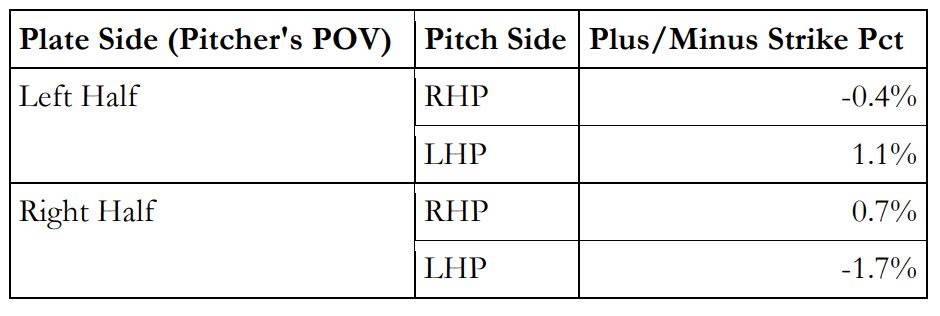
PITCHER HANDEDNESS- TABLE 6.1, Courtesy of SIS
———————————————————————————————————————

BATTER HANDEDNESS- TABLE 6.2, Courtesy of SIS
When running a query over at Baseball Savant, I checked Greinke’s total output versus left and right-handed hitters and found that he’s thrown 50.19% of his pitches to righties from 2013-2017; no edge given by the type of batter he faced. In 2018, he’s thrown 56.6% of his pitches to righties. Again, the results proved almost nothing in terms of an advantage. Just to be sure, I looked at the left and right edges of the strike zone based upon the applicable handedness in 2018. Just two pitches landed outside of the zone thrown inside to a right-handed hitter were called strikes. He lost three pitches (one in the zone, one outside) to balls that were incorrectly called.
The type of pitch thrown (breaking, offspeed, fastballs) and whether the pitcher was at home or away also showed no significant variation. It wouldn’t do any good looking at what types of pitches Greinke has thrown because it is completely random and irrelevant to the result.
One last study to reference is the correlation of stability between the four key players in the at-bat event; the pitcher, catcher, batter, and umpire. SIS ran an odd/even year studies in order to weed out inconsistencies as if there is a tendency for one (or more) of the four to be a factor in which pitches get favorably called (or vice versa). If there is a strong relationship, then it should be a high level of uniformity no matter what year is used. Table 7 contains the results and they come as no surprise.
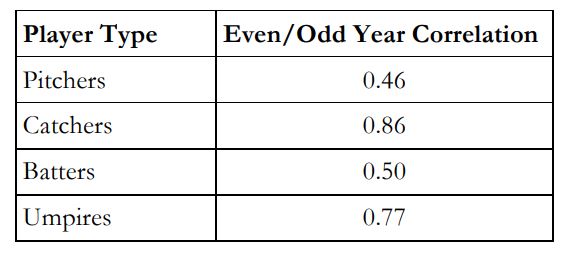
Table 7, Courtesy of SIS
The catcher is the biggest factor with the ump being nearly as apropos. So do we credit Mathis for Greinke’s fortune? It’s hard to say. Mathis did improve Greinke’s performance last season after having a bad year with Wellington Castillo. Given that Castillo has displayed almost no framing or run-saving skills, Mathis shouldn’t exactly be hoisted up on anyone’s shoulders. What is to be commendable is Mathis is currently in the top ten of every major framing category as of May 13th.
So what’s the conclusion? Well, we know that Greinke has been pretty inconsistent in terms of where he ranks in getting ‘phantom strikes’ and that he’s essentially had a different catcher each of the last several seasons, save for 2018. Furthermore, we found that pitchers have almost no influence on how a strike is called, regardless of their skill; catchers and their framing abilities stand tall in that department. Umpires are close to them and you don’t have any regularity in who you have to work with, yet they all seem to call pitches relatively the same under a given circumstance. There could be something to be said for pitcher/catcher consistency, as Greinke and Mathis are working together for the second straight season. It could simply be a comfort level and the two work really well together and Greinke just happens to be one of the most accurate pitchers in baseball, making Mathis’ job to pull outside pitches back in the zone for strikes that much easier.
-H/T to Mark Simon of SIS for generously providing the research paper
